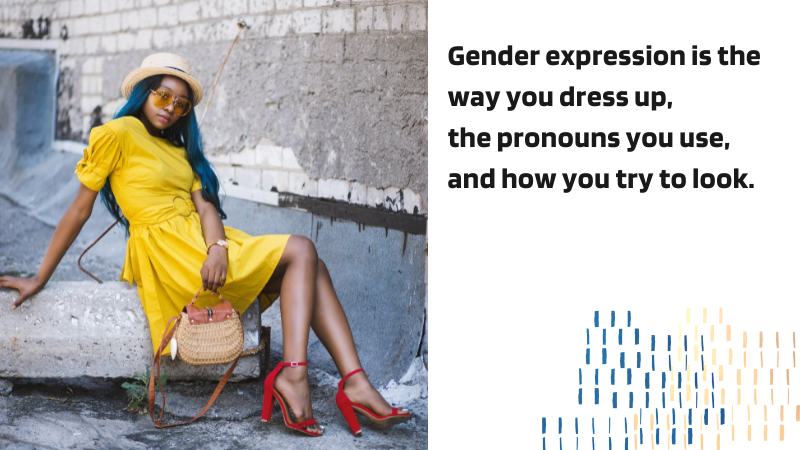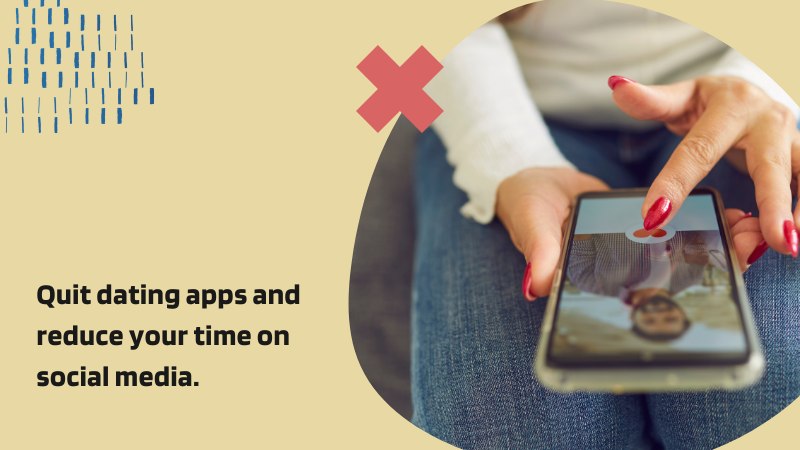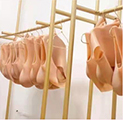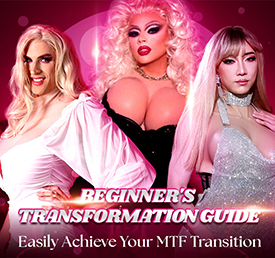Guidance and Advice for Teenage Crossdressers
Becoming a teenage crossdresser is almost never easy.
While it has some advantages, such as a higher chance of passing, it has at least twice as many aspects that can complicate things.
Sometimes, being able to express ourselves however we want can be a real struggle due to several aspects of our lives.
As teenagers, we tend to crave a certain level of freedom that often goes beyond what our parents allow us to have.
On top of that, being a teenager means you are experiencing a lot of self-questioning and making a lot of new discoveries.
This is why many crossdressers and transgender people discover their gender identity as teenagers.
And why I think this topic is important enough to write about in an article.

With that in mind, it’s important to consider how this stress affects the mental health of young drag traders.
The best way to guide you through this situation is to help you understand yourself better.
This introspection is vital in helping us figure out what you need and what you are going through.
Once we know this, we can begin to develop an action plan to aim for the best possible outcome.
Before we begin, remember that you are valid as a person and you should not be ashamed of who you are or who you want to be.
Figure out your motivation
What causes you to crossdress? This main question will help you figure out which of these techniques is more appropriate for your situation.
First, you must understand the concepts of gender identity, expression, and roles, as well as a few other concepts I’ll talk about later.

Gender identity: Your gender identity is your personal perception of yourself as Male, Female, both or neither.
These last two categories fit inside the “non-binary” umbrella, meaning that you don’t have to be exclusively male or female.
Gender identity is self-identified, but may be influenced by a combination of other factors.
It includes social and environmental circumstances.

Gender role: This one is better explained as what society expects from each gender, and what it considers to be male or female behaviours.
Gender roles are generally defined by someone’s gender identity, but that’s not always the case.
For example, some crossdressers may have a masculine gender identity.
However, they adopt feminine mannerisms and behaviours while en femme.
With that in mind, it’s worth to note that gender roles are different in each society, and vary according to their context.

Gender expression: Your gender expression can be summed up to the way you dress up, the pronouns you use and how you try to look.
The name itself is self-explanatory, as it’s the way you express yourself.
A person may have single gender expressions, as with cis or transgender people.
Or, in some cases, multiple expressions, as with crossdressers, non-binary and genderfluid people.
To be more precise, in the case of MTF crossdressers, they have a masculine expression most of the time.
But when they crossdress, they are showing a feminine gender expression.
Now that you know how it works, I want you to think about yourself.
What is exactly your identity? Consider how you feel about yourself as a male, female, both or neither, and think about gender roles.
Would you prefer to live as someone of the opposite gender?
If that’s the case, you’re most likely transgender.
If you’re not sure, but also doesn’t like to live with the gender you were assigned at birth, you may be non-binary.
In the case that this feeling changes with time, you may consider the possibility of being gender-fluid.
Last, but not least, you may feel satisfied living as someone of your assigned gender, but may want to express yourself in a different way.
If all you want to do is to sometimes adopt a different gender expression, you’re better fitted in the term “crossdresser.”

As a teenager, it may be too soon for you to tell, but you may have at least an idea of your identity by now.
Being yourself is a good motivation on it’s own, but some people may crossdress for other purposes.
Some may do that as a hobby, for fun.
Others do so as a form of art or entertainment, for themselves or for other people, and are usually known as “drag queens.”
Each form of crossdressing is valid, but as different as they are, different guidance is required.
So, before we proceed, I would like you to use all this information I gave you in order to find out what are your motivations to crossdress.
Dealing with dysphoria

Body dysphoria is a common concern among trangender people.
It can be described as a state of unhappiness and dissatisfaction with your gender expression.
People who experience body dysphoria tend to feel uncomfortable with being in their own bodies.
They say it doesn’t represent who they are on the inside.
It’s also common for them to compare their bodies with other people’s, finding what they consider to be flaws in their own appearance.
If not given the proper attention in earlier stages, this disorder may become an obsession.
This way, it may lead people to extreme and dangerous aesthetical procedures.

But how does someone deal with dysphoria? Well, the path towards self-acceptance is a long and arduous one, but also very rewarding.
To do so, you’ll need to understand that people come in every shape and size you can imagine.
The beauty standards that are presented to us are quite unrealistic, so feel free to ignore them.
It’s easier said than done, but we need to start somewhere.
A good advice in this matter is to quit dating apps and reduce your time on social media.
This way, you’re less exposed to impossible-to-achieve beauty standards, and improve your self-esteem a bit.
If you want to develop a certain male or female feature in your body such as a defined waist or muscles, try to find a gym near you.
Then, start a routine of exercises. This is also good to keep you healthy, and can be combined with a good diet.

However, if symptoms persist, and you feel that your dissatisfaction with your body is growing, it’s time to seek professional help.
Talk to a psychologist about your insecurities and gender identity.
They might help you to feel better about yourself and improve your self-esteem.
It is essential to prevent your dysphoria from developing into depression or something worse.
If you tell them you’re trans, they might refer you to an endocrinologist so you can start hormonal therapy, but that’s another topic.
Find enough time to dress up
If you happen to crossdress for any of the aforementioned reasons, you shouldn’t stay long periods of time without dressing up.
That’s because crossdressing can be a way for you to vent and to express a part of you that was repressed.
This kind of repression is bad for our psychological health, and can turn into a trauma if we let it.
To avoid this, you should adjust your routine and try to express yourself freely at least every two weeks.
I know sometimes we can’t manage to dress up that often, and that each person has its own reality.
But we can find some alternatives to reduce this repression.
Interacting with other crossdressers online is one of them, since it allows you to feel safe and be yourself.
Use it as an opportunity to talk about your crossdressing life and unleash this side of your personality.

For those who just need a little planning to fit regular crossdressing into their routines, I have a few tips as well.
The focus here is on teenage crossdressers. Thus, we must take into consideration school and their parents’ views towards crossdressing.
If you tend to have regular school assignments, my recommendation is to focus on it during the week in the afternoons if possible.
In most cases, any extra work can be finished on the Saturday morning or Sunday afternoon, so you have your Saturday night available.
Alternate weeks between crossdressing and going out with friends.
This way, you can dress up on a regular basis while maintaining an active social life.

If you have a busy life, there’s no problem dressing up every three weeks or even once a month.
The important thing is to stay true to yourself and never forget who you are.
Express yourself and let loose your crossdresser side one way or another.
Open up to people you trust
To keep everything as a secret may be fun to some people, but in most cases it’s prejudicial to their psychological health.
Hiding the fact that you crossdress from everyone may increase your levels of anxiety.
Or, at least create trust issues. The ideal is to talk about it to a couple of people you know and trust, in order to share the weight of the secret.
You must understand that what you’re doing isn’t wrong, and that you aren’t hurting anyone by expressing yourself.
Sharing this information with other people helps you to accept this fact, reduces your guilt and improves your confidence.

If you don’t trust anyone you know enough to open up, go see a psychologist.
Open up with them first, and then talk to them about trust issues, so maybe you can open up to more people.
It’s not so easy to “go see a psychologist” when you’re a teenager though.
You may need to talk to your parents about your mental health, or seek help from the infirmary in your school.
If neither of these options is available to you, it may still be possible to find help from an online therapy service.
Some of them are free or at least affordable.
Also, you can visit crossdressing blogs to listen to suggestions or experiences from mature crossdressers, and here is a recommended link: Sonia`s Crossdressing Blog.
About HRT and gender transitioning
Hormonal replacement therapy, or HRT, is a way to achieve gender transitioning.
It might be expensive, and comes with a risk for mental health.
But it’s considered the ultimate gender transition method.
If you want to change your body definitively and live as a trans person, I would say that’s the best way of doing so.
But you should keep in mind that hormones may affect your mood and your psychological health.
That’s why we experience a lot of new feelings and insecurities during puberty.

Speaking of puberty, teenagers must remember that their bodies are in constant change.
And that’s normal. Hormones will develop male or female features in each person’s body.
Most crossdressers can hide said features with certain techniques.
But it may not be enough for trans people, who tend to seek HRT.
They do so to develop their desired features, and suppress the undesired ones.
If that’s your case, make sure to talk to an endocrinologist, and follow up with a psychologist.
All of that is needed to make sure you’re ok throughout the duration of your therapy, if you choose to do it.
Never, by any means, do any kind of self-medication, as the help of specialists is the only safe way of doing HRT.
Administration of wrong hormonal dosages may result in depression and other serious issues.
Your relationship with your parents
Not every crossdresser has good relations with their parents, that’s a fact.
It’s not easy to come out to someone we don’t trust, and many LGBTQ teenagers face this harsh reality.
As I said before, keeping your identity a secret may result in serious cases of anxiety.
And this is the daily life of thousands of crossdressers worldwide.
Some have conservative or ignorant parents that won’t accept them for who they are.
To make things worse, they have little options besides repressing themselves.

That’s why I want to encourage you to talk about it with your parents.
Of course, you don’t need to straight up come out to them, but may try to change their minds with dialogue.
In the worst scenario, if they are too religious or uncooperative, you may need to wait a few years.
As a teenager, you have very limited options, as they have legal responsibility over you.
But once you reach the majority (18 years old in most countries), you are free to make your own choices.
Until then, for the sake of your mental health, avoid conflict with your parents.
Hide your crossdressing habits from them if you need to, and vent about it online to avoid anxiety.
If you think you can manage to dress up without them knowing, do so, but be careful.
My advice is to enlist the help of LGBTQ friends to help in hiding your crossdressing stuff.
Do so instead of storing it in your house, where your parents could easily find them.

Even though they may not understand you, they are still your parents, and might love you.
Make everything you can to ensure you keep a healthy relationship with them.
The lack of their support may cause further harm to your psychological health.
Keep in mind that it’s worth waiting until the majority.
At least, if it means your relationship with them will be maintained.
Patience is important, and is often the key to make your dreams come true.
It includes the dream of crossdressing or gender transitioning.
At least, without any trauma from your parental relations.
Learn More: If you don’t know how to explain it to mom and dad, have them read this article.
Validation and exposure
In search of validation, many crossdressers end up posting their pictures online.
It’s nice to get positive comments, and our self esteem is improved by that.
However, we must be careful with what we post, and where.
We have little to no control of where our pictures can end up on the internet, and what people do with them.
With that in mind, avoid over-exposing yourself online,
as your pictures may end up in the hands of ill-intentioned people.
My advice here is to post pictures without revealing too much of your body, avoiding compromising poses.
If you crossdress in secret, It’s also not recommended to show your face too much, as someone may recognise you.

Lastly, beware of internet trolls. They tend to make mean comments and say bad things about your appearance.
But don’t let them ruin your confidence, because that’s precisely what they want to do.
They are probably envious of how you look, and have nothing else to do.
They spend hours online mistreating people.
So, if they said something bad about you, they most likely said that to hundreds of people.
Don’t care for what they say. Instead, pay attention to the compliments you may get, as they are sincere and not spam.
That’s it for today. I hope my advice was useful, and that teenage crossdressers worldwide can use it as guidance.
Psychological health is a big concern among our community.
So, I consider it to be one of the most important topics to write about.
Good luck to everyone out there, and stay safe!
Tagged With:Crossdressing Teens , Teen CD , Teenage Crossdressers
- How to Hide a Bulge Without Tucking?
- How to Be a Sissy? A Beginner’s Guide to Sissification
- Why Femboys Should Try Sissy Training: Everything You Need to Know
- How to Take Crossdresser Pics to Document Your Transformation
- The Most Comprehensive Guide to Sissy Tasks for Every Level
- A Step-by-Step Guide to Huge Fake Pregnant Belly for MtF Crossdressers
Established in 2009, We are a recognized manufacturer and seller of professional crossdressing products.
It is our aim to become not just the most creative manufacturer but also a very considerate seller, as we provide the best quality products for crossdressers all around the world.



















 Breast Forms
Breast Forms  Body Suit
Body Suit  Realistic Mask
Realistic Mask  Femini Girdle
Femini Girdle Hip & Butt Enhancement (8)
Hip & Butt Enhancement (8) Penis Prosthesis
Penis Prosthesis Fake Muscle
Fake Muscle Bikini
Bikini  Wig
Wig  Corsets
Corsets Course
Course service@roanyer.com
service@roanyer.com +8618652200711
+8618652200711 Facebook
Facebook YouTube
YouTube Twitter
Twitter Instagram
Instagram




